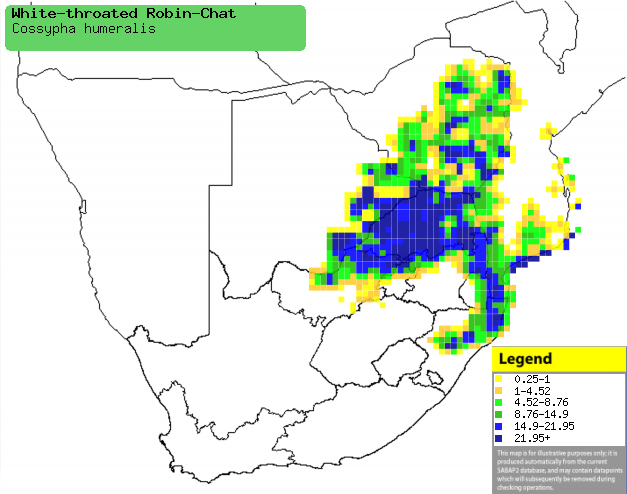|
Cossypha humeralis (White-throated
robin-chat, Whitethroated robin)
Witkeeljanfrederik [Afrikaans];
Witkeel-lawaaimaker [Dutch]; Cossyphe à gorge blanche [French];
Weißkehlrötel [German]; Cossifa-de-peito-branco [Portuguese]
Life
> Eukaryotes >
Opisthokonta
> Metazoa (animals) >
Bilateria >
Deuterostomia > Chordata >
Craniata > Vertebrata (vertebrates) > Gnathostomata (jawed
vertebrates) > Teleostomi (teleost fish) > Osteichthyes (bony fish) > Class:
Sarcopterygii (lobe-finned
fish) > Stegocephalia (terrestrial
vertebrates) > Tetrapoda
(four-legged vertebrates) > Reptiliomorpha > Amniota >
Reptilia (reptiles) >
Romeriida > Diapsida > Archosauromorpha > Archosauria >
Dinosauria
(dinosaurs) > Saurischia > Theropoda (bipedal predatory dinosaurs) >
Coelurosauria > Maniraptora >Aves
(birds) > Order: Passeriformes
> Family: Muscicapidae > Genus: Cossypha
Distribution and habitat
Endemic to southern Africa, occurring from Zimbabwe,
southern Mozambique and south-eastern Botswana to north-eastern South Africa. It
generally prefers thickets in Acacia and broad-leaved woodland, sand
forest, thorny scrub and the edges of dune forest, also occupying wooded suburbs
and farm gardens.
|
 |
|
Distribution of White-throated robin-chat in southern Africa,
based on statistical smoothing of the records from first SA Bird Atlas
Project (©
Animal Demography unit, University of
Cape Town; smoothing by Birgit Erni and Francesca Little). Colours range
from dark blue (most common) through to yellow (least common).
See here for the latest distribution
from the SABAP2. |
Brood parasites
It has been recorded as host of the
Red-chested cuckoo.
Food
It mainly eats insects supplemented with fruit and small
vertebrates, doing most of its foraging on the ground, flicking through leaves
in search of prey and occasionally hawking insects aerially. The following food items have been recorded
in its diet:
- Invertebrates
- Small vertebrates
- Fruit
- Capparis tomentosa (Woolly caper-bush)
- Antidesma venosum (Tassel-berry)
- Grewia microthyrsa (Sand raisin)
- Euclea divinorum (Magic guarri)
- Euclea racemosa (Dune guarri)
Breeding
- The nest is an open cup built of dead leaves and dry grass with a rim of
twigs, lined with coarse material such as tendrils, leaf fragments, midribs
and stalks. It is typically placed on the ground, such as in a hollow in a
tree stump, at the base of a vine, or even in an old pot or tin.
- Egg-laying season is from September-January, peaking from
October-November.
- It lays 2-3 eggs, which are incubated solely by the female for about
14-15 days.
- The chicks are fed by both adults, leaving the nest after about 13-14
days, but remaining dependent on their parents for about 6-7 more weeks.
Threats
Not threatened.
References
-
Hockey PAR, Dean WRJ and Ryan PG 2005. Roberts
- Birds of southern Africa, VIIth ed. The Trustees of the John Voelcker
Bird Book Fund, Cape Town.
|
